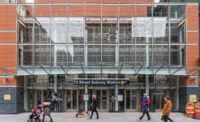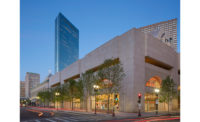Architecture and the Future of the Public Realm
As cities plan soft infrastructure, designers have an important role to play.

Photo © Michel Arnaud
It’s spring, and the economy is looking up. The Fed sees steady growth, unemployment is down, the stock market has been (mostly) up, and even the Architecture Billings Index is up. Architects also reported more new project inquiries, and in February, “new design contracts at architecture firms posted their largest monthly gain in over two years,” according to AIA chief economist Kermit Baker.
All this is good news for architects.
This month, however, RECORD is not spotlighting the type of work that’s mostly spurring the rise in billings. In this month's issue, we’re exploring projects that make a significant contribution to the public realm of cities and neighborhoods—what has come to be called “soft” infrastructure or social infrastructure. This includes urban design and landscape projects like parks and public plazas; facilities like libraries, health-care clinics, and social housing; and more traditional infrastructure like local and regional mass transit. Building these community-based projects is complicated and often drawn-out; they tend to be financed by multiple sources of public, private, and philanthropic dollars. And they are likely to have multiple stakeholders: architects are usually working collaboratively across disciplines, with landscape architects, engineers, and planners—and engaging with the community as part of the design process. All this requires patience, and may not do much to bolster a firm’s bottom line.
So why do architects even go there? We asked a number of them and got some provocative answers. Maybe the most surprising came from Thom Mayne, the Pritzker Prize–winner best known for his idiosyncratic works of architecture. Yet as Mayne tells RECORD, “The architecture world seems to be overly invested in design with a capital D . . . The problems in the 21st century are going to be much more infrastructural than architectural . . . I’m not giving up design; it isn’t either/or. But the most compelling work in front of us today is infrastructural."
Even if a project is private, community-based design thinking is a growing priority. “In the past, civic placemaking was more in the realm of government agencies,” says Charles Renfro, principal of Diller Scofidio + Renfro. “Now more of our private projects offer the opportunity to impact public experience. We want our buildings to be expansive, inclusive, and welcoming to people who would not normally think of themselves as invited in."
Enhancing the public realm is a way for people to connect across socioeconomic and other barriers that have polarized communities. “In an era when people are becoming more isolated, and perhaps less empathetic, public space is our only hope for bringing people together,” says Claire Weisz, principal of WXY, “especially spaces that serve multiple functions, like a plaza where you can run, or hold a health fair or have a wedding."
The determination of cities, assisted by foundations and other nonprofits, to improve and expand the civic spaces we all share has already had a profound effect on urban life, and in this issue we include several unbuilt projects that, if funded, would continue a positive trend.
But federal money, from agencies like HUD, is often a part of the patchwork of financing for such projects. As we watch Congress grapple with the administration’s proposed budget, the negative impact from possibly eliminating programs like the Community Development Block Grant is arousing real fear. Even small agencies like the National Endowment for the Arts—its very existence now under threat—have played an outsize role in promoting design excellence in the urban realm.
Underfunding the needs of cities has long been a concern. In 1968, Whitney M. Young, Jr., the civil rights leader and head of the National Urban League, spoke to the annual convention of the AIA and exhorted his almost all-white, male audience to challenge the inequity of the profession, and the injustice, poverty, and inequality faced, mostly by blacks and, mostly, in cities. “We are not at a loss in our society for the know-how. We have the resources,” said Young. “We are at a loss for the will.”
It is worth your while to read his speech, even if you argue that times have changed, that institutionalized racism is not what it was 50 years ago, that progress has been made. Because it is hard to argue that equity has arrived, and that the gap between haves and have-nots is not as wide as ever.
Where people come together, despite their differences, is in the civic realm—and the facilities and opportunities there should be the best that we can create. This is a good time for architects and for practice. And as leaders in our civil society, it is also a good time for us to stand up for the public good.







